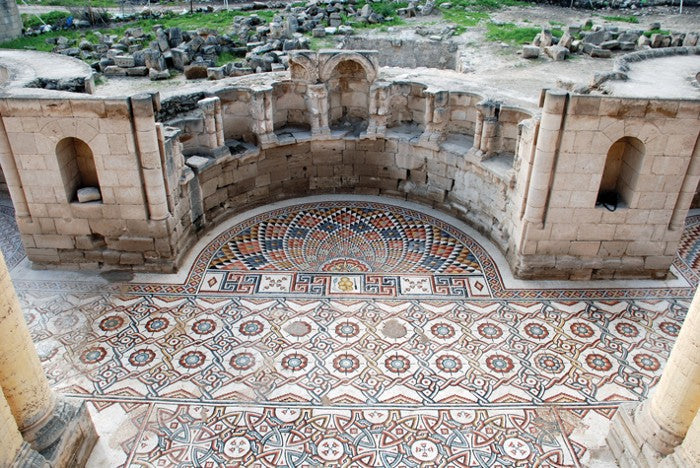Hisham’s palace, also known as Khirbat Al-Mafjar, is one fascinating archaeological home to some of the most prestigious and breathtaking mosaics in the world.
This palace returns to the 8th century, back to the Umayyad times. It was named after Hisham ibn Abd al-Malik, the 10th Umayyad caliph, who ruled from 724 until his death in 743.
This palace consists of many parts, such as a bathroom complex, an audience hall, a pool, a mosque, two main gates, a fountain, and the palace itself. It wasn’t the main home of the caliph, it was rather his own winter resort.
It’s a great touristic site that flourished even more after revealing the mosaic carpet in the audience haul by British archeologists in the early 1930s, that was later covered in soil for preservation purposes.
It’s one of the best representations of ancient Islamic art. Here are a few mosaic pieces from this archaeological phenomenon!
The Tree of Life

Inside the diwan of the bath complex, lies the palace’s most recognizable piece of art: “The Tree of Life”.
This beautiful piece of art depicts a huge fruity tree in the center, some gazelles gracefully walking towards it on the bottom-left side, and the bottom-right, we see a lion ferociously attacking another gazelle; this is meant to symbolize war and peace.
The subtle use of colors, the animalistic scene, and its impeccable details all show the amount of dedication that was put into crafting this mosaic, and it also shows the level of talent ancient artists possessed back in the Umayyad times.
Audience Hall Carpet

In this part of Khirbet Al-Majar, rests preserved what is archeologists believe to be the largest living mosaic artwork from ancient times.
It’s an impressive 30×30 meters of divided mosaic space, consisting mostly of medallions (circles) and squares. Other than the interrupting large columns.

It consists of 38 different carpets, all of which are extremely rich in vibrant colors and extremely accurate details.
The carpet is made out of seven million mosaic marble stones, with each marble stone having an area of one centimeter squared, and varying between approximately 21 colors.
Some missing patches are visible on the carpet, and that’s because of the earthquake that destroyed most of the palace in the year 747, leaving this carpet mosaic artwork damaged, as well as the rest of the palace.
The Audience Hall Apses

In the picture presented above, we see one of the 11 apses located in the audience hall. Each apse has its unique pattern, decorating the haul with beautiful and unusual geometric shapes and popping colors that catch the eye of any observer.
We can also see the damaged building and architectural monuments, showing just how rough the earthquake was.

The Floral Patterns

Another unique characteristic of the mosaic carpet is its floral richness, which was very common in the Islamic period.
When looking at the tree of life mosaic and the carpet in the audience haul, we can notice a theme; nature.
From the fruity tree of life to the floral richness, nature exists everywhere we go in this palace. This may be due to the fact that nature symbolizes spirituality and heaven in the Islamic world.
This palace has been through a lot, but thankfully, the mosaics inside of it remains mostly alive. It’s astonishing how art can survive after these many years, especially after suffering from a destructive earthquake.
If you want to decorate your home with colorful and unique mosaic artworks and create your own palace, make sure to visit our website for the best-quality mosaics!



3 commentaires
It was great to discover this site
Thank you for your interest! We’re thrilled to hear your enthusiasm for the mosaic temples. Stay tuned to our blog and social media channels for updates. Your support and excitement mean a lot to us!
Are you going introduce more of these mosaic temples around the world ?